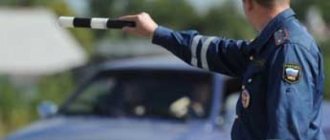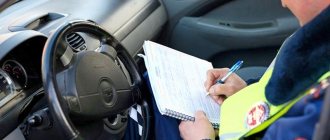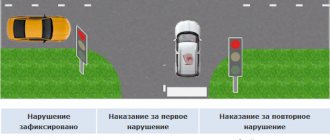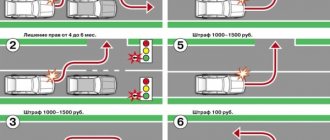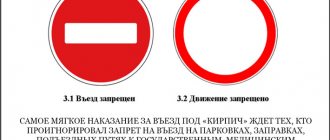The article will discuss possible traffic police fines for photo recording by the traffic police, as well as legal ways to challenge them. Today in Russia there are two main ways of recording offenses on the roads: independently by an inspector, or automatically using special devices. According to statistics, 9 out of 10 violations are detected by automatic systems.
Almost all cities have already installed video and photo recording devices. Their main task is to detect offenses and, as a result, reduce accidents on the roads. Thanks to them, traffic becomes increasingly safer. However, the driver does not always agree with the violation presented to him and trying to prove it on the spot will not work: everything happens automatically.
List of violations that can be detected by automatic systems
The list of recorded violations depends on the specific model of the device; the more expensive and technologically advanced it is, the more options it has. Today in the Republic of Belarus, most video cameras are capable of detecting speed limit violations and some others.
In large cities, cameras can detect the following offenses:
- entry into a lane intended for public transport (buses, trolleybuses);
- parking a vehicle in areas not designated for this purpose;
- driving beyond the stop line marked along with a traffic light or sign;
- not wearing a seat belt;
- entering a line intended for oncoming traffic;
- some other types of offences.
Features of video surveillance systems
The primary task of video cameras is to detect speed violations. Increasingly, cameras are being installed on dangerous sections of the road. It is important to note that the law sets some restrictions on the sanctions that can be applied for an offense recorded on camera. Thus, there are no restrictions if the violation was detected directly by the inspector (use of equipment in manual mode is allowed).
If a violation has been detected, the following rules automatically apply:
- for committing a violation for which administrative punishment is provided in the form of deprivation of a driver’s license, the latter is replaced by a fine in the amount of 5 thousand rubles;
- for committing a violation for which administrative punishment is provided in the form of a fine, its amount is determined according to the minimum limit established by the relevant article;
- administrative arrest is not imposed and is replaced by a fine.
How does a traffic inspector record a fine?
Familiar to every motorist, the radar can be mobile or stationary. The mobile version is most often used by traffic police officers - they record the appropriate speed limit in the assigned area. When using a mobile radar, establishing a violation with the consent of the driver is transferred to the category of an administrative fine.
The protocol is drawn up by the inspector on site. However, this does not always happen. The driver has the right to challenge the readings of the device, which leads to the launch of additional procedures. If the excess is punishable by law with a fine, the material about the administrative offense is sent for consideration to the traffic police authority at the place of registration. In the event that the article for which the driver is held accountable requires a court decision, the protocol is submitted to the court.
The inspector draws up a protocol in accordance with the established procedure
If you do not agree with the information specified by them in the protocol drawn up against you, you should find out how to appeal the decision on an administrative offense of the traffic police. This is exactly what we will talk about in a special article.
How to challenge radar readings
In order to make a decision, the traffic police officer must have with him accurate radar readings that were carried out in accordance with the established rules. If there are several cars or areas with different permissible speeds on the road, you need to obtain from the inspector specific evidence of involvement in violating road rules. In addition, the inspector must have a radar certificate with information about when the device was last checked, what error is permissible in the operation of the device, etc.
Radar readings are not always clear
If the violation is within the range of the maximum violable error of a portable fixation device, this will avoid penalties and resolve the issue in favor of the driver on the spot.
In any case, you need to remember the following: the device cannot give accurate readings if they were obtained from behind the glass of a patrol car or a stationary observation point. If the driver has established the fact of this violation, he has the right to enter this information into the traffic violation protocol. A traffic police officer has no right to refuse this to a motorist.
Amounts of fines
Article 12.9 of the Code of Administrative Offenses of the Russian Federation establishes a system that determines the amount of the penalty. The amount of the fine directly depends on the quantitative characteristics of the excess - the greater the excess, the greater the fine.
The fines are as follows:
- There is no liability for speeding above the established limit from 1 to 20 km/h;
- from 20 to 40 km/h the fine is set at a minimum limit of 500 rubles;
- for exceeding 40 - 60 km/h the fine will be 1 thousand rubles, for committing a repeated violation within 1 year from the date of the first protocol - 2 thousand rubles;
- if the violation is 60-80 km/h, the first fine will be 2,500 rubles, the second fine will be 5 thousand rubles;
- exceeding more than 80 km/h will cost 5 thousand rubles in both cases.
Next, we will consider the main way to legally avoid paying for an unreasonably imposed fine.
How to check whether a fine has been imposed for speeding
If a driver doubts whether a fine has been imposed on him for speeding, detected automatically (using photo or video recording) or is not sure that all current fines have been paid, you can check this by using our online traffic police fine search service. The check is carried out according to the “State Information System on State and Municipal Payments” (GIS - GMP) and covers the entire territory of the Russian Federation.
To carry out the check, you will need data from a valid driver's license (if the fine was imposed according to a resolution issued by a traffic police inspector) or a vehicle registration certificate (if the violation was recorded by a camera).
The search for fines is performed after filling out one of the fields (you can enter data from both documents in the search fields) and clicking the “Search for fines” button. The search process may take several minutes and ends with full information about the penalty imposed or a message that no fines were found.
The service also provides the ability to check the presence of fines by the number of the Resolution in the case of an administrative offense. To do this, you need to go to the “BY RESOLUTION NUMBER” tab.
How to cancel an illegally imposed fine
It is important to understand that modern cameras rarely fail and make mistakes in measuring speed. Therefore, it makes sense to try to overturn the decision only if there is complete confidence and evidence. There are 10 workers available to appeal the decision from the moment the letter is received by mail. Cancellation is possible by sending a complaint to an official, or by going to court. There is no specific sequence and you can go straight to court.
IMPORTANT !!! One of the most common situations is when the driver was not the owner of the car, but another person. The video recording system, regardless of who was in the car at the time the violation was committed, will generate a decision against the owner. This case is the simplest - you just need to provide any evidence of absence from driving to the inspectorate and the protocol will be canceled. You can ask the offending driver to confirm the information - this should be enough.
If there are other disagreements, when the owner himself was driving, it makes sense to draw up a written appeal to the body on whose behalf the decision was made. On a certain day, the driver will be invited to analyze the video recording. Together with the inspector, he reviews the recording in good quality. As a result, the decision is either canceled or remains in force. If you do not agree with the official’s decision, you should go to court. At the hearing, the judge will analyze the recording and make a decision. After the court decision enters into legal force, 70 days are allocated to pay the fine, after which the fine will be declared unpaid and appropriate sanctions will be imposed.
IMPORTANT !!! It is worth noting that the cancellation of a fine associated with exceeding the maximum permissible speed is unlikely, even if a tracker with a speed recording function was installed in the car. Unlike a camera, the device in cars is not a certified speed measuring device and a judge is more likely to believe the data from a CCTV camera.
The highest probability of canceling a decision is in the following cases:
- the camera recorded another car (differences in make, color or other);
- discrepancy in the state registration number;
- the speed is clearly too high (when the vehicle is not capable of accelerating to such values according to its technical characteristics);
- if the recording device does not have the appropriate certificate;
- upon expiration of the statute of limitations;
- when sending a repeated fine for the same violation.
Thus, the possibility of canceling a fine imposed using automatic systems is present, but this requires either undeniable evidence or system failures, which occur quite rarely. Each case is individual and it is impossible to give an unambiguous answer, but in case of controversial situations, you should seek help from a qualified lawyer. With its help, the chances of canceling an unfairly imposed fine will increase significantly.
How to challenge a fine from a photo/video camera
It is possible that you receive fines with photographs for violations committed by a person who has the right to drive a vehicle with you. In this, as well as in other dubious cases, you can challenge the fine from the camera by contacting TsAFAP - the center for automatic recording of offenses. By the way, the person who was driving the vehicle at the time of the violation can also be brought there. If this person confirms what you said, then the decision is made against him, and yours, accordingly, is canceled.
More on AutoLex.Net:
Traffic police fines: find out the debt by last name, check, payment of traffic police fines
In the center you will watch a video of the moment your car violated traffic rules in excellent quality, and in color. With the help of this video, you can also examine other controversial issues related, for example, to running into a stop line, etc. If the driver believes that the traffic police fines with the photo were issued to him unreasonably, then he will need to write a free-form application-complaint to TsAFAP. By the way, it can also be sent by email, after which the driver will be invited to an administrative review.
If, after a second joint review of all the details, the driver does not agree with the decision, then the case is sent to court, where the judge will make a decision after watching the same video. Usually in such cases the validity of the fine is confirmed, and if you do not pay it within 70 days, the fine will become unpaid.
But you are unlikely to be able to challenge a speed fine from a camera (except for the method described in the video below) , even if you have data from a GPS dash cam at the time the violation was committed. These devices are not certified speed measuring devices, and in court you will be believed less than data from a video recording camera. Therefore, obey the speed limit, and if you do receive a fine, the validity of which you agree with, pay it on time.

